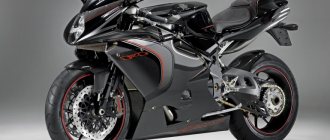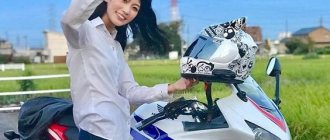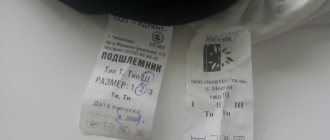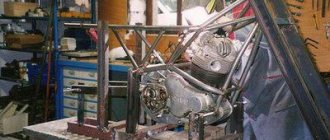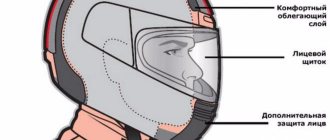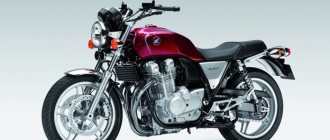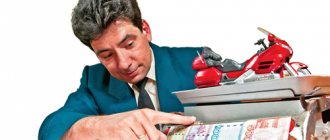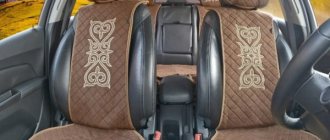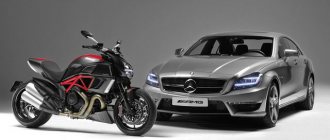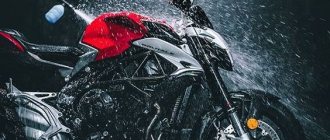This article was written specifically for those who want to change their bike. You can immediately make a reservation - do not have too high hopes for a used motorcycle. First of all, proceed from the thesis: “I will buy it cheap, but how much money will it take to fix it later.” When buying a second-hand item, problems are usually identified after several trips. As a rule, it is better to buy more expensive, but of higher quality. You can, of course, buy all the parts separately and assemble the motorcycle by hand, but do you have enough time, money and patience for this?
If the seller asks for too high a price and does not agree to reduce it, even after all the identified disadvantages, feel free to send him on a walking trip. There will be other, more respectable sellers, and in principle, purchasing a motorcycle does not require any rush.
So, below is a list of basic rules for successfully choosing the right bike. Print this checklist and check it point by point on the spot
.
Before inspection:
- Read forums, official websites and other resources dedicated to the model you have decided to purchase. In any case, someone encountered problems. Read about these problems. It is possible that some problems may be common for a particular motorcycle. If there is no description of your problem, ask experienced owners about it. In most cases, they will always be happy to help you.
- Look how much your bike costs on sales sites (Avito or auto.ru). In what condition they are sold, pay attention to chains, tires, sprockets.
- Carefully examine the photo of the proposed bike. If flaws are already visible in the photo, look at the cost of purchasing and replacing parts, and again point this out to the seller. If he only posted photos in poor quality, this is already a “red flag” that the seller is trying to hide the shortcomings of the motorcycle from you.
- Write a message to the seller with questions that interest you. How many kilometers does it run, what are the shortcomings, reason for sale, registration, etc.
- Take with you to the inspection a flashlight, wrenches, a screwdriver, a rag, a notepad and a pen, and if you have one, a tire pressure gauge. Write down each identified flaw so as not to forget and approach the seller with this list.
Buy the motorbike that suits you best.
Unlike cars, which have adjustable seats and an adjustable steering wheel, many motorcycles do not have different adjustments for the comfort of the driver and passenger. So, friends, don’t expect that when you buy any motorcycle, it will be comfortable for you and it will be comfortable to sit on. For the most part, you need to know that you will sit on the motorcycle in exactly the position dictated by the design itself and its manufacturer.
See also: Ten best motorcycles for a beginner
Sportbikes and cruiser motorcycles are designed in such a way that the rider's body is leaned forward. The tilt angle behind the wheel of such motorcycles is quite strong. People end up slouching a lot when riding these bikes. It is quite possible that driving a sportbike will not be very comfortable for you. Therefore, remember, before buying a sports bike, you must check its comfort, whether it is comfortable for you to sit behind the wheel.
We also draw your attention to the fact that it may not be possible to immediately determine whether this sport bike is convenient for you in these few minutes in the showroom.
The point is this: if you feel quite comfortable while sitting behind the wheel of a sports bike in these minutes, this does not mean that you will also be comfortable behind the wheel further, for example, after half an hour or several hours while driving it.
Sitting motionless in a motorcycle showroom and riding this motorcycle for a long time are not the same thing at all.
Of course, the most important parameter for the convenience of a motorbike for a novice driver is the height of the motorbike itself. If, while sitting behind the bike, both your feet touch the asphalt, then this gives more confidence to any novice motorcyclist who, at first, is very afraid of traffic lights, where they have to stop and get to their feet. It will be much better if a novice driver touches the road with both feet rather than touching it with one foot. To do this, you need to buy for yourself a motorcycle that is not tall (with a low seating position).
The second important factor in choosing a motorcycle is the weight of the motorcycle. Remember, friends, that the heavier the bike, the harder it is to control at low speed. Thus, based on this parameter, we do not advise novice motorcyclists to immediately buy a heavy motorbike as their first motorcycle.
Check it out at the meeting point:
- First of all, check the documents for the motorcycle and the correspondence of the numbers on the frame - you don’t want to buy a stolen one.
- If the motorcycle needs tire replacement (tread wear or microcracks), this is already a reason to reduce the price from your seller
- Look at the geometry, the sides should be symmetrical, nothing should be loose, the parts should be in place
- Pay attention to the exhaust pipe. If it is bent or twisted, this indicates possible accidents in the past.
- The wheel should not wobble or wobble when rotating.
- Check the headlights for integrity and functionality, the housing for cracks and scratches, the horn and turn signals
- No exposed wires, blue tape or hand-held clamps - all wiring must be neatly secured inside the motorcycle.
- Be sure to check the fuel tank for rust and dents, both outside and inside (this is where a flashlight comes into play)
- There should be no leaks or traces of oil or gasoline around the sealed joints on the engine; there should also be no leaks under the motorcycle or on the rear suspension. Even if everything is visually in order, but you smell oil or gasoline or oil, it means there is still a leak somewhere. Try to find her.
- Check the level of antifreeze, brake fluid, engine oil (everything should indicate the correct level). Some motorcycles do not have special gauges that indicate fluid levels (Harley-Davidsons from the 1970s, for example). To do this, unscrew the tank cap by hand and check the level by eye. By the way, the inside of the tank should also not be dirty, there should be no traces of rust, and the oil should not be black.
- The chain should be clean and lightly oiled, and the sprocket teeth should be sharp.
- Check the battery terminals - they should be clean, free of oxidation and deposits (if there is white powder or traces of corrosion on the positive terminal, the batteries need to be replaced).
- The gear shift lever should give in freely when pressed for the first time, and then you will feel the gear shift. Same thing with the brake lever. The levers should only “move” up and down, without wobbling to the sides.
- Run your finger along the fork legs, there should be no oil on it
- Sit on the motorcycle, apply the front brake and use a rocking motion back and forth to load the front shock absorbers. They should work smoothly, evenly and without “breakdowns”.
- Check the wear of the pads and brake discs
- Touch the engine with the back of your hand - it should be cold (if the seller arrived with it, let the engine cool). A hot engine can hide many internal problems. Then grab the exhaust pipe and shake the bike. Everything should be securely fastened, there should be no “cracks” or noises.
- Start the engine. The start should be fast, the speed should not float, there should be no extraneous knocks
- If you are satisfied with everything, ask about the history of parts replacement.
After purchase, we recommend immediately changing the oil and oil filter. Look at the contamination of the air filter; if it is dirty, replace it too.
In general, neither when driving, nor when sitting quietly in the garage, your future bike should not make any unnecessary noise. It starts up quickly and without “dancing with a tambourine”, during and after the trip there are no smells of gasoline or burning, the sound of the engine when driving is a pleasant rumble, and not a crazy roar. Well, if you imagine that after a whole day of driving around in it you still don’t want to part with it – congratulations, you’ve found the perfect option!
Well, don't forget to bargain! The seller always advertises his bike as more expensive than it actually costs, and never talks about all the shortcomings. Under no circumstances do we encourage you to pay pennies or deliberately deceive the seller. Any good product is worth its money.
Write in the comments what else you can check, we’ll add it to the list and put together a complete checklist.
New or used?
Most likely, after this part of the article, what our readers will read further, certain motorcycle enthusiasts will not be very happy with our expressed opinion. But still, definitely, and there is a reason for this, we believe that the first motorcycle should be used. Why? We answer. Firstly, if, after some training in driving a motorcycle and after obtaining a category “A” license, it turns out that riding a motorcycle is not your thing, then selling used motorcycles is much easier than selling a completely new motorcycle. The thing is that the demand for motorcycles in our country leaves much to be desired, and since a used bike costs much less than a new one, it will be much easier to find a buyer for it.
Moreover, a new motorcycle purchased for yourself seriously loses its price in the first year of operation. Thus, we believe that while you still don’t know whether you will like this very motorcycle world, you should first buy a used motorcycle for yourself, and not a new one.
Secondly, for the initial acquisition of independent motorcycle riding skills in the first year, it will not matter to you which motorcycle you ride. And in this case, it will naturally be preferable to buy a used motorbike.
In addition, due to your limited driving experience, this motorcycle may fall and be damaged. If you damage a new motorbike, the loss of money will be quite large, and repairs will cost you much more than the same used motorbike.
Plus, maintaining a new motorcycle will cost you much more than a used bike. And according to the same statistics, beginners rarely damage their motorcycles in the first year of ownership. So we recommend that it would be more expedient and smarter to buy yourself an initially used motorbike.
Suzuki SV650.
This bike itself is narrow and quite light, which will help beginners quickly gain riding experience. In addition, the engine of the Suzuki SV650 is reliable and easily copes with the mistakes of beginners. This is quite a small and good motorcycle bike. But this size is ideal just for the duration of training and for gaining sufficient experience for the subsequent purchase of more serious equipment. Thus, until your skills become better and more confident, you should not buy a large and heavy motorbike for yourself.
In addition, this motorcycle has quite a variety of spare parts and components. Please note that you should purchase only those models that are equipped with an anti-lock braking system (ABS), which will help a beginner avoid accidents and falls.
This model can only be purchased in used condition (the model has already been discontinued). The ABS system appeared on this model in 2007. The average cost of a used model in Russia is approximately 250 thousand rubles. Here are private advertisements for the sale of this model.
Take a test drive before purchasing.
Of course, in order to understand whether this or that motorcycle is right for you, you must first conduct a real test of it, that is, get behind the wheel yourself. But the problem here lies elsewhere; many motorcycle dealers will never agree to give you the opportunity to test a motorcycle in real conditions. This is not a car.
However, friends, this test is very important. After all, having read about this or that model of motorcycle bikes, even all the available information, having fully studied the reviews of the owners about them, you will not get a real idea about this motorcycle until you personally ride it.
The only opportunity to drive such a motorcycle, the exact model you have dreamed of and want to buy, is to join a motorcycle club in advance or undergo training at a driving school where exactly these models of motorcycles are used. Also, perhaps one of your friends or acquaintances has such a motorcycle and they will be able to give you the opportunity to test this type (model) of a motorbike, at least for a few minutes.
Gas tank and carburetors
The gas tank can tell a LOT about the history of a motorcycle. Be sure to look into it, make sure that the walls are not covered with a coating of rust - this is a clear sign that the motorcycle spent a lot of time in the open air with an empty tank, perhaps even without a lid. If there is rust, you can be sure that it will settle in the carburetors (many used motorcycles have carburetors). This means you will have to spend money on an expensive service with complete disassembly, cleaning, replacement of locking needles, subsequent adjustment and synchronization. Carburetors (especially on motorcycles that have been standing for a long time, in particular those delivered from Japan) will have to be cleaned one way or another. This operation is inevitable, since gasoline, gradually evaporating from carburetors, leaves a fraction resembling cement in hardness at the bottom of the float chamber, jets, thin air and fuel channels. But a rusty tank! It is almost impossible to wash it from the inside. This means that you are doomed to forever clean the carburetors of your motorcycle.
The seller will foam at the mouth and insist that if you throw a handful of nuts into the tank, pour gasoline and shake it properly, it will become like new. Don't believe it. For some time after such treatment, the inside of the tank may shine, but the corrosion process will continue..
And by the appearance of the gas tank, you can indirectly judge whether the bike has been in an accident. If in the front part of the tank, to the right or left of the steering column, there are small, one might say, neat dents, then you know that when it fell, it cut off the limiters on the frame, and at the same time on the fork, it reached the gas tank and dented it. In this case, it is likely that not only the tank was damaged, but also the fork itself, the front wheel, and perhaps even the base of the motorcycle - the frame.
Kawasaki 250/300 Ninja.
When it comes to Kawasaki sport bikes, many experienced motorcyclists unanimously say that the Kawasaki 250 Ninja model, or at least the 300 Ninja model, is ideal for beginners. It may be too early for many novice drivers to purchase this type of sport bike, but for those who have successfully completed motorcycle driving training at a driving school and quickly began to feel quite confident behind the wheel of a motorcycle, such models will be an ideal solution for them for the first purchase of a sports motorcycle. Read more…
Difference between VIN code and frame number
To protect vehicles from theft, special tags have been developed. At first these were ordinary frame numbers, which were 9 characters from the factory.
As world trade developed, the ISO 3779 standard was adopted, in which, in addition to the plant number, 6 digits were added to distinguish cars from different countries of production. In modern vehicles, VIN codes are used instead of frame numbers.
The VIN structure consists of 17 characters, divided into blocks of information.
| Meaning | Symbol by account |
| World Index | 1-3 |
| Vehicle characteristics | 4-8 |
| Result of mathematical formula (for control check) | 9 |
| Year of issue | 10 |
| Factory code | 11 |
| Serial number | 12-17 |
Any scooter with an engine of 400 cc or higher.
Many of you will be surprised that we suggest buying a scooter as your first motorcycle? This is no joke, friends. This type of motorcycle occupies a special niche in the motorcycle world. Believe us, many professional motorcycle racers love scooters for their lightness, handling and special design. As a first motorbike for most new motorcyclists, it would be best to purchase any model of scooter with an engine capacity of 400 cc or more.
Thanks to the sufficient engine capacity and power of the scooter, you can ride it on any road.
Yes, of course, you are right in some ways, this type of equipment is not for those who need ambitions on the road, for whom it is important to show everyone their importance. But nevertheless, with this modest technique you can quickly gain sufficient experience in driving two-wheeled motor vehicles. Think about it, friends.
Triumph Bonneville.
Another motorcycle model that is ideal for novice drivers. Thanks to its low stance, powerful engine and handling, and the model's undeniable reliability, the novice motorcyclist will not feel uncomfortable behind the wheel of this Triumph Bonneville.
The most preferred model here is the 2012 model, which is equipped with an 850 cc engine and has a power of 68 hp.
Another thing that is noteworthy here is that this motorcycle may not only be the first for many, perhaps it will become your main motorized vehicle in the future, when you gain sufficient experience in motorcycling. Read more…
Transmission
There are three types of SHE on motorcycles. The first is a cardan drive (most often it can be found on heavy “neoclassics”, “touring” and “cruisers”). Such a transmission can only be checked on the go, in a test drive. To do this you will have to break the Rules and not wear a helmet. Listen to whether the final drive gears are whining in the rear axle (this can be heard already at speeds from 60 to 80 km/h). Ask the manager (or try it yourself, if you are entrusted with the steering wheel) to sharply increase and release the gas several times while driving: will there be unpleasant knocking noises - a sign of increased gaps in the splines and gears from a very long or improper operation of the transmission.
The second type of drive to the rear wheel is a chain. The condition of the chain drive is easier to determine. Grab the chain with two fingers where it fits onto the rear large sprocket, at its outermost point, and try to pull it back. If this succeeds, it means that the chain is very worn and must be replaced. The chain, which has exhausted its resource, begins to intensively gnaw on both sprockets - both front and rear. Eventually you will have to change them too.
The third drive option - a toothed belt - is quite rare, as a rule, on choppers that do not have high engine power and speed. Although I once had the opportunity to test a super-powerful “Boss Hoss V8” with a seven-liter engine from a “Chevrolet Tahoe”, in which a Kevlar belt served as a drive from the automatic transmission to the rear wheel. It is good because it requires virtually no maintenance. You just need to monitor its tension and avoid excessive contamination.
Kawasaki 900 Vulcan.
This is a cruising motorcycle with a medium weight. The weight of this Kawasaki 900 Vulcan is 282 kg, which is quite suitable for a novice rider. The V-shaped engines of the Kawasaki 900 Vulcan motorbike are quite powerful and are considered very reliable today.
It is worth noting right away that despite the fact that the engine capacity of this bike is 903 cc, the power of this power unit for beginners is quite conservative, it is only 48 hp. Read more…
Front fork
THIS DETAIL also requires attention during inspection. It is convenient to check the fork on the motorcycle when it is standing on the center stand. Have someone push on the back of the bike or just sit in the passenger seat. When the front wheel begins to spin freely in the air, grab both legs of the fork as close to the bottom of the fork as possible and wiggle it. If the fork is heavily worn, you will immediately feel it by the beating of the feathers in the guide bushings.
In addition, the fork may dangle in the steering column (due, in all likelihood, to the fact that the upper and lower bearings have “run out”). This seemingly innocent play can turn into a tragedy on the highway. At a decent speed - usually well over a hundred - the front wheel suddenly begins to “walk” from side to side in an ascending amplitude. Most often this ends in a fall. Therefore, if you discover such a defect, be sure to bring it to the attention of the manager and agree either to carry out repairs before selling, or to receive an appropriate discount. But worn bearings must be replaced immediately.
On motorcycles that are not equipped with a center stand (such as sportbikes), it is more difficult to check the front fork. A well-equipped service center must have a special stand for this.
After you've held the chrome ends of the fork legs, look at your hands to see if there are any traces of oil on them? If there is, it means the seals are leaking and, as a result, the fork hydraulics may not work properly. And in addition, the oil, flowing down the feathers, will certainly end up on the brake pads. And oiled brakes have never brought happiness to anyone...
